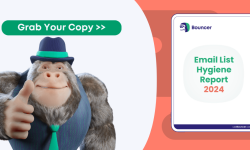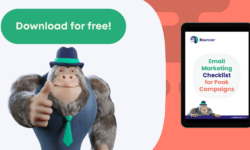Email copywriting refers to the words used in the emails you send. However, it’s important to ensure that you know that it doesn’t only apply to the body of the email. The email copy starts from the subject line, includes the preview text, the body of the message, CTAs, and everything else.
The words you write when sending an email influence people to check it out and engage with it and can make all the difference regarding whether or not your emails are effective in increasing conversions and sales. What you say when sending an email is often much more effective than what you show with templates, images and colourful buttons and elements. You’re likely to experience poor conversions even if your email copy is not up to scratch, even if you have a great design.
The good news is that whether you are new to email marketing or it is something that your business has been doing for a while, there are several things that you can do when it comes to focusing on the elements mentioned above, having more appeal when it comes to your audience and writing copy that gets great conversion rates.
Marketing Copywriting – Don’t Write for Everybody
This tip can often seem quite counterintuitive when just starting with email copywriting. It’s not uncommon for many writers to believe that if they make an effort to talk to everybody, they will be able to reach a wider audience compared to getting more specific. However, this can be a huge mistake and could result in fewer people reading your messages and being interested enough to engage with and take action due to your email.
When you are writing an email message or any kind of marketing copy online, it’s best to write for a certain audience segment, tailoring your voice, tone, offer, and everything else to make it as relatable as possible to them. For example, an email targeting women in the 18-25 age group will differ from an email aimed at 40–50-year-old men.
Because of this, when you write, it’s crucial to focus on your audience and consider their problems, aspirations, the language they are used to reading in, and more so that you can focus on writing specifically for them.
Copy for Marketing CTAs
CTAs or call to action describe an invitation for your reader to take a specific action. However, one of the biggest mistakes some marketers make is thinking that clicking the link is where the action starts and ends. The action you want your reader to take should be the end goal, whether buying a product, booking an appointment, reading an article, signing up for a free trial, etc.
When including CTAs in your emails, a suitable copy will not only make your message clear but also ensure that it is effective. Start by determining the main goal that you want to accomplish. Then, write your CTA and use a strong verb for a short call to action phrase. However, that being said, you don’t want to end up relying too much on the CTA to do everything. If your email is redirecting to a sales page, for example, then don’t put the buy button in the email straight away, as the main job of the CTA button is to get the reader to visit the sales page, where the buy button is a CTA in its own right. Instead, something like ‘Find Out More’ or ‘Check it Out’ gives your reader more information on what they will do next before allowing them to make the final buying decision on the sales page.
Copywriting in Marketing – Subject Lines for Email
The subject line is one of the most important aspects of email marketing to consider when it comes to copywriting, as it is usually the first thing a recipient will see when your email message lands in their inbox. Today, we are getting more and more marketing emails each day, and if subject lines don’t stand out from the crowd, they will struggle to be noticed amidst hundreds of other unopened emails.
Because of this, it’s essential to spend time coming up with subject lines designed to speak to your audience and grab their attention for the right reasons. You can use several techniques, including humour, scarcity, personalisation, intrigue, FOMO, and even emojis, to make your subject line stand out in the inbox and get the attention that it deserves.
Once you have written the subject line, the preview text is the next area to focus on. This is often the first line of the email and is shown underneath the subject line in the inbox for some email clients. The main aim of the preview text should be to provide readers with more context into the content of the email. Make sure that it stays under fifty characters, so it fits the area where it’s shown, and use it to add more information to the subject line rather than simply reiterating it.
Copy Marketing – Copy Length
When it comes to how long you will write for and how many words you’ll include, it all depends on several factors, such as the type of audience, resources, product, and marketing goals. There is no magic number of words that have been proven to work for email copywriting, as it’s different for every business and target audience.
For example, an eCommerce email will often be quite concise and to the point. On the other hand, if your latest project is copywriting for an email newsletter, then this might be longer, as it is more informative and might contain several articles, tips and tricks, and more.
When it comes to how long your copy will be, you first need to consider the type of audience you are targeting. If your main target audience is busy and has little free time, they will likely appreciate a shorter, more to-the-point email they can skim through on their lunch break. On the other hand, if your main target audience are people that are looking into buying an expensive course or signing up for something that involves much commitment, then you can usually get away with writing a longer, more detailed email that ensures they are provided with all the in-depth information that they need to make the right decision.
Copy and Marketing – The Customer Journey
When it comes to copywriting for email marketing, you should always have the customer journey at the forefront of your mind so that you are not pushing people into making a purchase either too early or too late. When writing emails, this should be done while considering the level of trust the reader has in your brand.
This is one of the main reasons why the first email you should send to new subscribers is the welcome email. This allows you to get the new relationship with your latest subscriber off to the most successful start, creating an onboarding journey where readers can be introduced to your company and what you do and where they can learn more about it. Once this foundation has been laid, your new subscriber can become a part of your ongoing content newsletters and campaigns. This allows you to expose them to your emails and brand over time, gradually building more trust before introducing sales emails.
Email Copywriting Best Practices
To get better results from your email copywriting efforts, the following best practices should be followed:
1 – Understand Your Audience
Gather as much information as possible about your target audience before connecting with your prospects. Otherwise, this will prevent you from writing a compelling email and converting prospects into paying customers. Using email marketing software can help you know your audience more.
2 – Focus on Subject Lines
It’s important to place special focus on the email subject lines when copywriting for email marketing. Readers will not be interested in opening the email in their inbox or even noticing it if the subject line is not exciting and compelling.
3 – Personalise
It’s a fact that email copywriting should be personalised to improve the results and get more deals. Email copy should be written like a direct conversation with your customers. Even if you send the email to hundreds of people, personalisation techniques will help you avoid showing that in your email copy.
4 – Keep it Simple
Last but not least, avoid using industry jargon and write in a conversational, easy to understand way. Break text up into short sentences and paragraphs, allowing readers to skim the email to take it in quickly.
Copywriting for email marketing can be all the difference between your emails being ignored or increasing conversions.
👉 Get more tips for an effective email marketing campaign!


